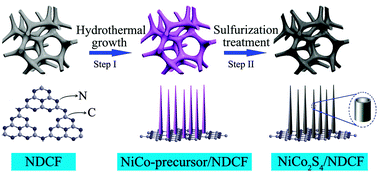NiCo2S4 nanotube arrays grown on flexible nitrogen-doped carbon foams as three-dimensional binder-free integrated anodes for high-performance lithium-ion batteries†
Abstract
Binary metal sulfides, especially NiCo2S4, hold great promise as anode materials for high-performance lithium-ion batteries because of their excellent electronic conductivity and high capacity compared to mono-metal sulfides and oxides. Here, NiCo2S4 nanotube arrays are successfully grown on flexible nitrogen-doped carbon foam (NDCF) substrates with robust adhesion via a facile surfactant-assisted hydrothermal route and the subsequent sulfurization treatment. The obtained NiCo2S4/NDCF composites show unique three-dimensional architectures, in which NiCo2S4 nanotubes of ∼5 μm in length and 100 nm in width are uniformly grown on the NDCF skeletons to form arrays. When used directly as integrated anodes for lithium-ion batteries without any conductive additives and binders, the NiCo2S4/NDCF composites exhibit a high reversible capacity of 1721 mA h g−1 at a high current density of 500 mA g−1, enhanced cycling performance with the capacity maintained at 1182 mA h g−1 after 100 cycles, and a remarkable rate capability. The excellent lithium storage performances of the composites could be attributed to the unique material composition, a rationally designed hollow nanostructure and an integrated smart architecture, which offer fast electron transport and ion diffusion, enhanced material/–electrolyte contact area and facile accommodation of strains during the lithium insertion and extraction process.

- This article is part of the themed collection: 2016 most accessed PCCP articles

 Please wait while we load your content...
Please wait while we load your content...